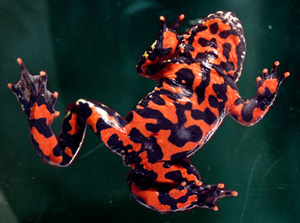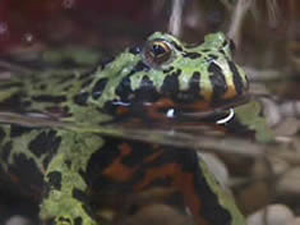Fire-bellied Toad - Bombina orientalis
Native to southern and southeastern Asia, Fire-Bellied toads are noted for their bright green and black coloration on their backs, and brilliant orange and black on their underside. These bright colors serve as a warning to predators. While not the most toxic of amphibians, regular handling is not recommended (avoid if there are cuts on your hands) and your hands should always be washed thoroughly immediately after touching the toad. Oriental fire bellied toads are hardy little toads that are suitable for beginners. They are not difficult to care for, although they do take a fair amount of work to maintain. The toads are very active and tend to get a little noisy at times.
DO NOT FEED WILD INSECTS OR INSECTS FOUND AROUND THE HOUSE – THEY MAY CARRY DISEASES AND PESTICIDES THAT COULD BE DEADLY TO YOUR PET
Average Size 2 to 3 inches long
Life Span Up to 5 + years
Diet - Fire-bellied toads will eat almost anything that will fit in their mouths. Provide a variety of live insects, including small, gut-loaded (recently fed) crickets and worms. Dust the insects daily with a pure calcium supplement and once or twice weekly with a vitamin/mineral supplement. Learn how to raise food for your pet.
Feeding - Feed fire-bellied toads every other day, placing food on the land area of the tank; provide only as much food as they can eat in one feeding
Housing - A group of 5-6 toads can be kept in an 18 gallon aquarium with about 4 inches of water. 1/4 of the surface should be kept dry and will primarily be used as a feeding area. Put floating plants in the aquarium, the toads will spend time floating among these. Keep water temperature at 68-75ºF.
Substrate - Mulch-type commercial material; unbleached paper towels, soil, dampened sphagnum moss, and bark; avoid gravel and artificial turf (too harsh for skin).
Temperature – Should range from 65 degrees F. to 82 degrees F.
Water - Use dechlorinated water; a canister filter is needed to keep the habitat clean and prevent disease
 Normal Behavior and Interaction - Fire-bellied toads spend most of their time in the water; Males call when they are ready to breed; the call is quite unusual, sounding like a dog's bark; They recognize routine; feed them at the same time every day and you'll find them waiting; One of the few communal toads, they live together in the wild Normal Behavior and Interaction - Fire-bellied toads spend most of their time in the water; Males call when they are ready to breed; the call is quite unusual, sounding like a dog's bark; They recognize routine; feed them at the same time every day and you'll find them waiting; One of the few communal toads, they live together in the wild
Habitat Maintenance - Remove left over food and feces daily to keep the water clean and clear. Use an appropriate sized, small-mesh, soft net to move or block the toad while doing habitat maintenance; avoid handling; if you handle them be sure to wear latex gloves; residue or oil on your skin can harm amphibians. Thoroughly clean the tank at least once week: set toads aside in a secure habitat; scrub the tank and furnishings with a 3% bleach solution; rinse thoroughly with water, removing all smell of bleach; add clean, dechlorinated water; ensure temperature range is from 75 F. to 85 F before returning toads to the tank
Recommended Supplies:
- Habitat with secure lid
- Basking rock or log
- Humidity gauge
- Substrate/commercial mulch
- Book about toads
|
- Canister filter
- Fish net or scoop
- Incandescent light or ceramic heater
- Thermometer
- Vitamin/mineral supplement
| Gender Identification - Males generally have rougher backs and their forearms are thicker than the females. These minor differences make them almost identical except during the breeding season, when males have black horny nuptial pads on their fingers and forearms. One way of telling which toads are male and which are female is to observe the behavior of the toads. Whenever a toad tries to jump on the back of another toad and use the arms to grasp it, it's definitely a male. If the male isn't rejected immediately, there is a good chance that the second toad is a female and that she is even prepared to breed.
Breeding - There are several ways of trying to make your pet ready to breed. A 6-8 week hibernation period at 50ºF will usually do the job. Remember to lower the temperature gradually over a period of a week before the hibernation and similarly raise the temperature gradually afterwards. Another method that sometimes works is to change most of the water in their aquarium and replace it with water that is a few degrees colder. When the toads are ready to breed the males begin calling. The sound is somewhat like the sound of a small dog barking at some distance. The males constantly try jumping on the backs of any other toad in the vicinity. If a male inadvertently jump on the back of another male, the second male makes a special croak just to inform him that he's made a mistake. If a female is present and she's ready to breed, she'll swim around with a male on her back and the eggs will be attached singularly or in small groups to plants, rocks, roots or whatever can be found in the water. One female may produce more than two hundred eggs. Using fine gravel or sand will make it a lot easier to remove the eggs when the toads start breeding
The eggs should be transferred to another aquarium. After 3 days at 77ºF the eggs will hatch. For another 3 days, while consuming the yolk sac, the tadpoles don't move around at all. After that they'll begin swimming around, trying to find something to eat. The tadpoles can be raised on finely crushed flakes, frozen or freeze dried fish food. The hind legs will begin to break through about 3 weeks after the eggs hatched and the arms will begin to appear about a week later. Five weeks after hatching, the first toads will go through metamorphosis and will be ready to leave the water.
The young toads will eat any kind of small insects and larvae. They'll be ready to breed before they are a year old. The eggs of younger and smaller females tend to be fewer and smaller in size.
Grooming and Hygiene Don't handle unless necessary; wear latex gloves; do not allow toad's skin toxins into contact with eyes, mouth, or open wounds While not the most toxic of amphibians, regular handling is not recommended (avoid if there are cuts on your hands) and your hands should always be washed thoroughly immediately after touching the toad. Wash your hands after handling the habitat contents to help prevent Salmonella and other infectious diseases. To learn more about Salmonella see healthlawyers.net
Signs of a Healthy Pet:
- Active and alert
- Healthy skin
- Clear eyes
|
- Eats regularly
- Clear nose and vent
- Hopping and swimming
|
Common Health Issues and Red Flags:
- Lethargy
- Skin lesions
- Loss of appetite
- Distressed breathing
|
- Weight loss
- Weak leg movements
- Bloated abdomen
|
- Chemical Intoxication - Caused by exposure to soap detergents and pesticides. May be lethal; be sure to protect your pet from exposure.
Intestinal Obstruction - Caused by swallowing gravel or by eating too many hard- shelled insects. Consult with an exotic animal veterinarian; surgery may be required.
Nutritional Deficiencies - Weak hind legs, lethargy, lighter or darker skin color. Ensure a varied diet; use vitamin and mineral supplements.
Skin Problems - Abrasions, bacterial and fungal infections. Consult with an exotic animal veterinarian for treatment.
Metabolic bone/vitamin deficiency – inability to absorb calcium due to insufficient UVB light. This can result in deformities and soft bones, swollen limbs and lethargy. Contact your veterinarian.
Vitamin A Toxicity - This is a common problem that occurs when your pets are over supplemented. Many multi-vitamins contain levels of VitA and should be offered sparingly. Toxicity is characterized by a swelling of the throat and eyes, and proceeding to a bloating of the body and lethargy.
Internal Parasites - Symptoms of internal parasites include weight loss, worms in the stools, runny stools, gaping and listlessness. If you observe a combination of these symptoms you should take your pet to a veterinarian to have a stool sample examined to determine if there are any parasites present and if so, what kind they are. Follow their recommendation for treatment.
If you notice any of these signs, please contact your exotic animal veterinarian.
As with all pets in this category, it is important that you find a veterinarian that practices in EXOTICS – this is critical. The typical small animal practitioner may not have sufficient knowledge in this area.
Even this guide is general in nature and should not be used to diagnose your pet.
|



 Normal Behavior and Interaction - Fire-bellied toads spend most of their time in the water; Males call when they are ready to breed; the call is quite unusual, sounding like a dog's bark; They recognize routine; feed them at the same time every day and you'll find them waiting; One of the few communal toads, they live together in the wild
Normal Behavior and Interaction - Fire-bellied toads spend most of their time in the water; Males call when they are ready to breed; the call is quite unusual, sounding like a dog's bark; They recognize routine; feed them at the same time every day and you'll find them waiting; One of the few communal toads, they live together in the wild